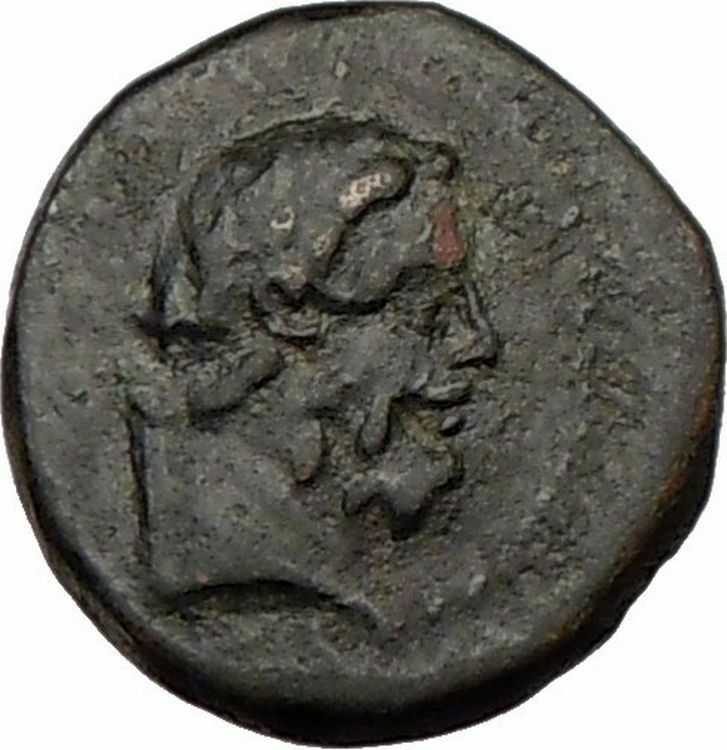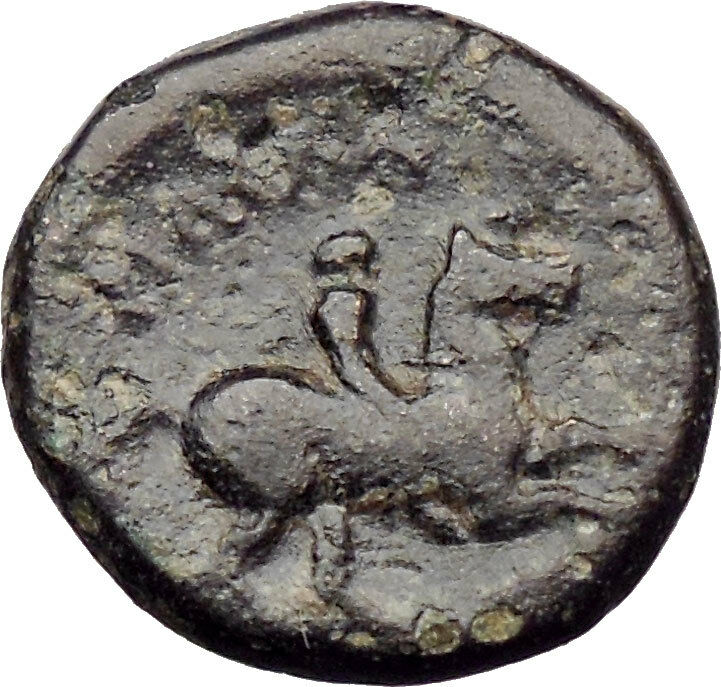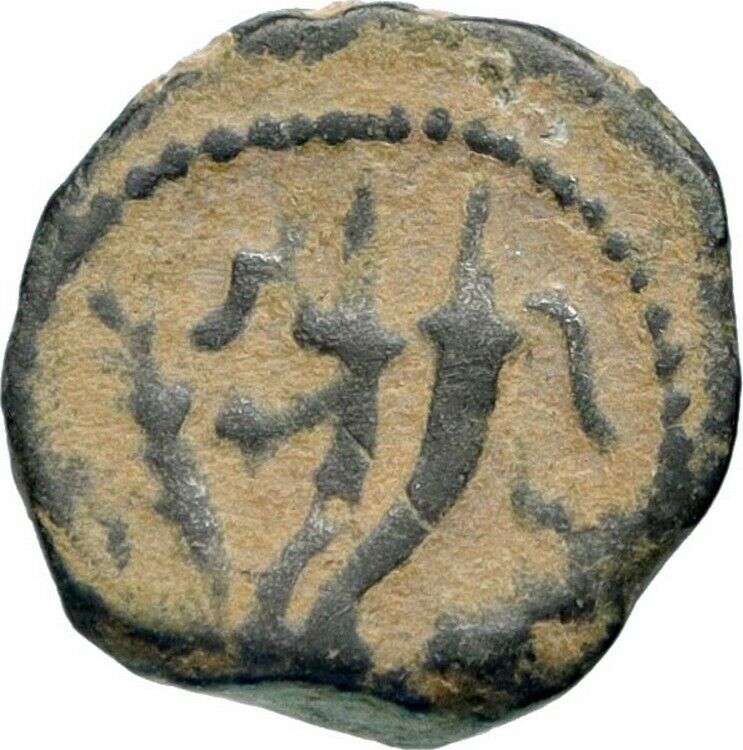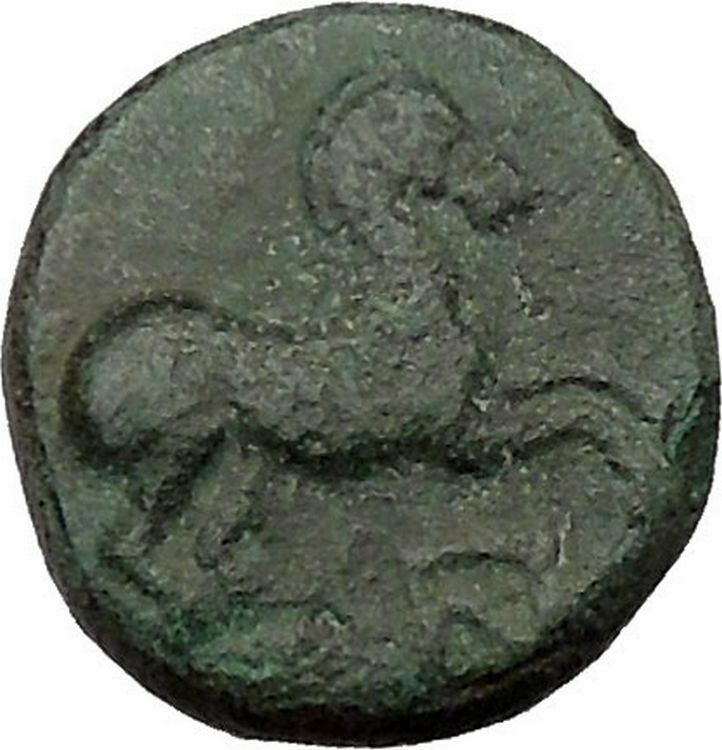|
Greek city of
Phokaia in
Ionia
Bronze 12mm (1.61 grams) Struck circa 350-300 B.C.
Reference: Sear 4537; B.M.C.14.216,92
Head of nymph Prokaia left, hair in sphendone.
Head of griffin left.
A coastal city of considerable importance, situated forty
miles north-west of Smyrna, Phokaia was one of the first mints, producing
electrum coinage from early in the 6th century until the time of Alexander, a
series that was produced in conjunction with the Lesbian mint of Mytilene.
You are bidding on the exact item pictured,
provided with a Certificate of Authenticity and Lifetime Guarantee of
Authenticity.

In this 1896 painting by
John William Waterhouse
,
Hylas
is abducted by the
Naiads
, i.e. fresh water nymphs

Echo,
an Oread
(mountain nymph) watches
Narcissus
in this 1903 painting by
John William Waterhouse
.
|

A
nymph (Greek:
νύμφη, nymphē) in
Greek mythology
and in
Latin mythology
is a minor female nature deity
typically associated with a particular location or landform. Different from
goddesses, nymphs are generally regarded as divine spirits who animate nature,
and are usually depicted as beautiful, young
nubile
maidens who love to dance and sing;
their amorous freedom sets them apart from the restricted and chaste wives and
daughters of the Greek
polis
. They are believed to dwell in
mountains and
groves
, by springs and rivers, and also in
trees and in valleys and cool
grottoes
. Although they would never die of old
age nor illness, and could give birth to fully immortal children if mated to a
god, they themselves were not necessarily immortal, and could be beholden to
death in various forms.
Charybdis
and
Scylla
were once nymphs.
Other nymphs, always in the shape of young maidens, were part of the
retinue
of a god, such as
Dionysus
,
Hermes
, or
Pan
, or a goddess, generally the huntress
Artemis
. Nymphs were the frequent target of
satyrs
.
Etymology
Nymphs are personifications of the creative and fostering activities of
nature, most often identified with the life-giving outflow of springs: as
Walter Burkert
(Burkert 1985:III.3.3) remarks,
“The idea that rivers are gods and springs divine nymphs is deeply rooted not
only in poetry but in belief and ritual; the worship of these deities is limited
only by the fact that they are inseparably identified with a specific locality.”
The
Greek
word
νύμφη has “bride” and “veiled” among its meanings: hence a marriageable
young woman. Other readers refer the word (and also
Latin
nubere and
German
Knospe) to a root expressing the
idea of “swelling” (according to
Hesychius
, one of the meanings of
νύμφη is “rose-bud”).
Adaptations
The Greek nymphs were spirits invariably bound to places, not unlike the
Latin genius loci
, and the difficulty of
transferring their cult may be seen in the complicated myth that brought
Arethusa
to Sicily. In the works of the
Greek-educated
Latin poets
, the nymphs gradually absorbed into
their ranks the indigenous Italian divinities of springs and streams (Juturna,
Egeria
,
Carmentis
,
Fontus
), while the
Lymphae
(originally Lumpae), Italian
water-goddesses, owing to the accidental similarity of their names, could be
identified with the Greek Nymphae. The mythologies of classicizing Roman poets
were unlikely to have affected the rites and cult of individual nymphs venerated
by country people in the springs and clefts of
Latium
. Among the
Roman
literate class, their sphere of influence
was restricted, and they appear almost exclusively as divinities of the watery
element. Nymphs are also portrayed as selfish and as attention seekers who walk
around naked in the middle of forests.

Heraldic guardian griffin at
Kasteel de Haar
, Netherlands
The griffin, griffon, or gryphon (Greek:
γρύφων, grýphōn, or γρύπων, grýpōn, early form γρύψ,
grýps;
Latin
: gryphus)
is a
legendary creature
with the body, tail, and
back legs of a lion
; the head and wings of an
eagle
; and an eagle’s talons as its front feet.
As the lion was traditionally considered the king of the beasts and the eagle
was the king of the birds, the griffin was thought to be an especially powerful
and majestic creature. The griffin was also thought of as king of the creatures.
Griffins are known for guarding treasure and priceless possessions.
Adrienne Mayor
, a classical folklorist,
proposes that the griffin was an ancient misconception derived from the
fossilized remains of the
Protoceratops
found in gold mines in the
Altai mountains
of
Scythia
, in present day southeastern
Kazakhstan
, or in
Mongolia
.In antiquity it was a
symbol
of
divine power
and a guardian of the divine. Some
have suggested that the word griffin is cognate with
Cherub
.

The Islamic
Pisa Griffin
, in the
Pisa Cathedral
Museum
Form
While griffins are most common in the art and lore of
Ancient Greece
, there is evidence of
representations of griffins in Ancient Persian and
Ancient Egyptian art
as far back as 3,300 BC.[5][6]
Most statues have bird-like
talons, although in some older illustrations griffins have a lion’s
forelimbs; they generally have a lion’s hindquarters. Its eagle’s head is
conventionally given prominent
ears; these are sometimes described as the lion’s ears, but are often
elongated (more like a
horse
‘s), and are sometimes feathered. The
earliest depiction of griffins are the 15th century BC
frescoes
in the
Throne Room
of the
Bronze Age
Palace of
Knossos
, as restored by Sir
Arthur Evans
. It continued being a favored
decorative theme in Archaic and Classical Greek art. In
Central Asia
the griffin appears about a
thousand years after Bronze Age Crete, in the 5th–4th centuries BC, probably
originating from the
Achaemenid Persian Empire
. The Achaemenids
considered the griffin “a protector from evil, witchcraft and secret slander”.[7]
The modern generalist calls it the lion-griffin, as for example,
Robin Lane Fox
, in Alexander the Great,
1973:31 and notes p. 506, who remarks a lion-griffin attacking a stag in a
pebble mosaic
Dartmouth College expedition
at
Pella
, perhaps as an emblem of the kingdom of
Macedon or a personal one of Alexander’s successor
Antipater
.

Achaemenid
griffin at
Persepolis
.
The Pisa Griffin
is a large bronze sculpture which
has been in Pisa
in Italy since the Middle Ages, though it
is of Islamic
origin. It is the largest bronze
medieval Islamic sculpture known, at over three feet tall (42.5 inches, or 1.08
m.), and was probably created in the 11th century in
Al-Andaluz
(Islamic Spain).[8]
From about 1100 it was placed on a column on the roof of
Pisa Cathedral
until replaced by a replica in
1832; the original is now in the Museo dell’ Opera del Duomo (Cathedral Museum),
Pisa.
Infrequently, a griffin is portrayed without wings, or a wingless
eagle-headed lion is identified as a griffin; in 15th-century and later
heraldry
such a beast may be called an alce
or a keythong. In heraldry, a griffin always has forelegs like an eagle’s
hindlegs; the beast with forelimbs like a lion’s forelegs was distinguished by
perhaps only one English herald of later heraldry as the opinicus.
Medieval lore

Statue of a griffin at
St Mark’s Basilica
in
Venice
.
Griffins not only mated for life, but also, if either partner died, then the
other would continue throughout the rest of its life alone, never to search for
a new mate. The griffin was thus made an emblem of the Church’s views on
remarriage
[dubious
–
discuss
]. A
Hippogriff
is a legendary creature, supposedly
the offspring of a griffin and a mare. Being a union of a terrestrial beast and
an aerial bird, it was seen in
Christendom
to be a symbol of
Jesus
, who was both human and divine. As such
it can be found sculpted on some churches.[1]
According to Stephen Friar’s New Dictionary of Heraldry, a griffin’s
claw was believed to have
medicinal
properties and one of its feathers
could restore
sight
to the
blind
.[1]
Goblets fashioned from griffin claws (actually
antelope
horns) and griffin eggs (actually
ostrich eggs) were highly prized in medieval European courts.[9]
When it emerged as a major
seafaring power
in the
Middle Ages
and
Renaissance
, griffins commenced to be depicted
as part of the
Republic of Genoa
‘s coat of arms, rearing at
the sides of the shield bearing the
Cross of St. George
.
By the 12th century the appearance of the griffin was substantially fixed:
“All its bodily members are like a lion’s, but its wings and mask are like an
eagle’s.”[10]
In architecturee
In architectural
decoration the griffin is usually
represented as a four-footed beast with wings and the head of an
eagle
with
horns
, or with the head and beak of an eagle.[citation
needed]
The statues that mark the entrance to the City of London are sometimes
mistaken for griffins, but are in fact (Tudor) dragons, the supporters of the
city’s arms
.[13]
They are most easily distinguished from griffins by their membranous, rather
than feathered, wings.
In literature
Griffins are used widely in
RumiPersian poetry
is one such poet who writes in reference to griffins.[16]
In
Dante Alighieri
‘s
Divine Comedy
, Beatrice meets Dante in
Earthly Paradise after his journey through Hell and Purgatory with Virgil have
concluded. Beatrice takes off into the Heavens to begin Dante’s journey through
paradise on a flying Griffin that moves as fast as lightning.
Sir John Mandeville
wrote about them in his
14th century book of travels:
John Milton
, in
Paradise Lost
II, refers to the legend of
the griffin in describing
Satan
:
In
The Son of Neptune
by
Rick Riordan
,
Percy Jackson
,
Hazel Levesque
, and
Frank Zhang
are attacked by griffins in
Alaska
.
In the
Harry Potter
series, the character
Albus Dumbledore
has a griffin-shaped knocker.
Also, the character
Godric Gryffindor
‘s surname is a variation on
the French griffon d’or (“golden griffon”).
Pomponius Mela- ” In Europe, constantly falling snow makes those places
contiguous with the Riphean Mountains so impassable that, in addition, they
prevent those who deliberately travel here from seeing anything. After that
comes a region of very rich soil but quite uninhabitable because griffins, a
savage and tenacious breed of wild beasts, love- to an amazing degree- the gold
that is mined from deep within the earth there, and because they guard it with
an amazing hostility to those who set foot there.” (Romer, 1998.)
Mandeville- “In this land are many gryffons, more than in other places, and
some say they have the body before as an Egle, and behinde as a Lyon, and it is
trouth, for they be made so; but the griffen hath a body greater than 8 lyons,
and stall worthier than a hundred eagles. For certainly he wyl beare to his nest
flying, a horse and a man upon his back, or two oxen yoked together.” (speaking
of the land called Bactria)
Isidore of Seville- “The Gryphes are so called because they are winged
quadrupeds. This kind of wild beast is found in the Hyperborean Mountains. In
every part of their body they are lions, and in wings and heads are like eagles,
and they are fierce enemies of horses. Moreover they tear men to pieces.” (Brehaut,
1912)
[18]
Modern uses

The red Griffin rampant was the coat of arms of the dukes of
Pomerania
and survives today as the
armorial of
West Pomeranian Voivodeship
(historically,
Farther Pomerania
) in Poland.

Similarly, the coat of arms of
Greifswald
, Germany, in
Mecklenburg-Vorpommern
, also shows
a red griffin rampant — perched in a tree, reflecting a legend about
the town’s founding in the 13th Century.

Rogue taxidermy
griffin,
Zoological Museum, Copenhagen

Flag of the
Utti Jaeger Regiment
of the Finnish
Armymy
The griffin is the symbol of the
Philadelphia Museum of Art
;
bronze
castings of them perch on each corner of
the museum
‘s roof, protecting its collection.[19][20]
Similarly, prior to the mid-1990s a griffin formed part of the logo of
Midland Bank
(now
HSBC).
The griffin is the logo of
United Paper Mills
,
Scania
<!–, and of
Vauxhall Motors
and its former group partners
SAAB-Aircraft
and
Saab Automobile
. The latest fighter produced by
the SAAB-Aircraft company bears the name of “Gripen”
(Griffin), but as a result of public competition.
General Atomics
has used the term “Griffin Eye”
for its intelligence surveillance platform based on a Hawker Beechcraft King Air
35ER civilian aircraft[21]
Griffins, like many other fictional creatures, frequently appear within works
under the fantasy
genre. Examples of fantasy-oriented
franchises that feature griffins include
Warhammer Fantasy Battle
,
Warcraft
,
Heroes of Might and Magic
,
Dungeons and Dragons
(see
Griffon (Dungeons & Dragons)
),
Ragnarok Online
,
Harry Potter
,
The Spiderwick Chronicles
, and
The Battle for Wesnoth
.
In professional sports
The
Grand Rapids Griffins
professional hockey team
of the
American Hockey League
.
Amusement parks
Busch Gardens Williamsburg
‘s highlight
attraction is a dive coaster called “Griffon”, which opened in 2007.
Use of the
word for real animals
Some large species of
Old World vultures
are called griffines,
including the
Griffon Vulture
(Gyps fulvus). The
scientific name for the
Andean Condor
is Vultur gryphus, Latin
for “griffin-vulture”.
Origin
A theory, postulated primarily by
Adrienne Mayor
, is that the griffin originated
with ancient paleontological observations brought by long-distance traders to
Europe along the
Silk Road
from the
Gobi Desert
in Mongolia, where white fossils of
Protoceratops
are naturally exposed against
reddish ground. Such fossils, seen by ancient observers, may have been
interpreted as evidence of a half-bird-half-beast.t.[27][28]
Over repeated retelling and drawing recopying its bony neck frill (which is
rather fragile and may have been frequently broken or entirely weathered away)
may become large mammal-type external ears, and its beak may be treated as
evidence of part-bird nature and lead to bird-type wings being added.
Phocaea, or Phokaia, (Greek:
Φώκαια) (modern-day
Foça in Turkey
) was an ancient
Ionian
Greek
city on the western coast of
Anatolia
.
Greek colonists
from Phocaea founded the colony
of Massalia (modern day
Marseille
, in
France
) in 600 BC,
Emporion
(modern day
Empúries
, in
Catalonia
,
Spain
) in 575 BC and Elea (modern day
Velia
, in
Campania
,
Italy
) in 540 BC.
Geography
Phocaea was the northernmost of the Ionian cities, on the
boundary with Aeolis
. It was located near the mouth of the
river Hermus (now
Gediz
), and situated on the coast of the
peninsula separating the Gulf of
Cyme
to the north, named for the largest of the
Aeolian
cities, and the Gulf of
Smyrna
(now
İzmir
) to the south.
Phocaea had two natural harbours within close range of the
settlement, both containing a number of small islands. Phocaea’s harbours
allowed it to develop a thriving seafaring economy, and to become a great naval
power, which greatly influenced its culture.
Recent archaeological surveys have shown that the city of
Phocaea was large for the archaic period. Herodotus gives an idea of the size of
Phocaea by the describing the walls of Phocaea as having a diameter of 5 km,
large even by modern standards. Phocaea was one of the largest cities in the
ancient world.

Map of Aegean showing the location of Phocaea.
History
The ancient Greek geographer
Pausanias
says that Phocaea was founded by
Phocians
under
Athenian
leadership, on land given to them by
the Aeolian
Cymaeans
, and that they were admitted into the
Ionian League
after accepting as kings the line
of Codrus
. Pottery remains indicate Aeolian
presence as late as the
9th century BC
, and Ionian presence as early as
the end of the 9th century BC. From this an approximate date of settlement for
Phocaea can be inferred.
According to
Herodotus
the Phocaeans were the first Greeks
to make long sea-voyages, having discovered the coasts of the
Adriatic
,
Tyrrhenia
and Spain. Herodotus relates that
they so impressed
Arganthonios
, king of
Tartessus
in
Spain
, that he invited them to settle there,
and, when they declined, gave them a great sum of money to build a wall around
their city.
Their sea travel was extensive. To the south they probably
conducted trade with the Greek colony of
Naucratis
in
Egypt
, which was the colony of their fellow
Ionian city Miletus
. To the north, they probably helped
settle
Amisos
(Samsun) on the
Black Sea
, and
Lampsacus
at the north end of the
Hellespont
(now the
Dardanelles
). However Phocaea’s major colonies
were to the west. These included
Alalia
in
Corsica
,
Emporiae
and
Rhoda
in Spain, and especially Massalia (Marseille)
in France.
Phocaea remained independent until the reign of the
Lydian
king
Croesus
(circa 560–545 BC), when they, along
with the rest of mainland Ionia, first, fell under Lydian control and then,
along with Lydia (who had allied itself with
Sparta
) were conquered by
Cyrus the Great
of
Persia
in 546 BC, in one of the opening
skirmishes of the great
Greco-Persian conflict
.
Rather than submit to Persian rule, the Phocaeans abandoned
their city. Some may have fled to
Chios
, others to their colonies on
Corsica
and elsewhere in the
Mediterranean
, with some eventually returning
to Phocaea. Many however became the founders of
Elea
, around 540 BC.
In 500 BC, Phocaea joined the
Ionian Revolt
against Persia. Indicative of its
naval prowess,
Dionysius
, a Phocaean was chosen to command the
Ionian fleet at the decisive
Battle of Lade
, in 494 BC. However, indicative
of its declining fortunes, Phocaea was only able to contribute three ships, out
of a total of “three hundred and fifty three”. The Ionian fleet was defeated and
the revolt ended shortly thereafter.
After the defeat of
Xerxes I
by the Greeks in 480 BC and the
subsequent rise of Athenian power, Phocaea joined the
Delian League
, paying tribute to Athens of two
talents
. In 412 BC, during the
Peloponnesian War
, with the help of
Sparta
, Phocaea rebelled along with the rest of
Ionia. The
Peace of Antalcidas
, which ended the
Corinthian War
, returned nominal control to
Persia in 386 BC.
In 343 BC, the Phocaeans unsuccessfully laid siege to
Kydonia
on the island of
Crete
.
During the
Hellenistic period
it fell under
Seleucid
, then
Attalid
rule.
It was later briefly under the control of
Benedetto Zaccaria
, the
Genoan
ambassador to
Byzantium
; Zaccaria amassed a considerable
fortune from his properties there. It remained a Genoese colony until it was
taken by the Turks in 1455. It is a
titular see
of the
Roman Catholic Church
.
Coinage
Probably following the Lydians, the Phocaeans were among the
earliest in the world to make and use coins as money. Its earliest coins were
made of electrum
, a naturally occurring alloy of silver
and gold. The
British Museum
has a Phocaean coin containing
the image of a seal dating from 600–550 BC.
|



















